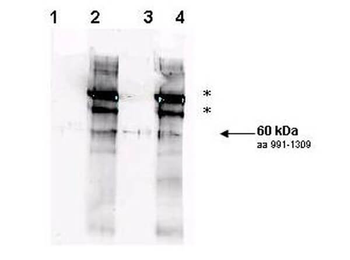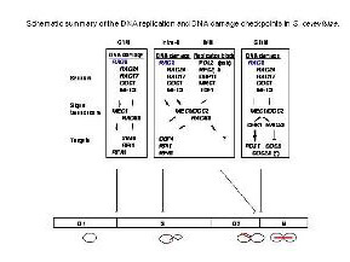You have no items in your shopping cart.
Rad9 (phospho-S1260) antibody
Catalog Number: orb345440
| Catalog Number | orb345440 |
|---|---|
| Category | Antibodies |
| Description | Rad9 (phospho-S1260) antibody |
| Species/Host | Rabbit |
| Clonality | Polyclonal |
| Tested applications | ELISA, WB |
| Reactivity | Yeast |
| Isotype | IgG |
| Immunogen | This affinity purified antibody was prepared from whole rabbit serum produced by repeated immunizations with a synthetic peptide corresponding to phosphorylated form of an internal region near aa 1225-1275 from the aa1309 yeast Rad9 protein conjugated to KLH. |
| Concentration | 0.41 mg/mL |
| Dilution range | ELISA: 1:5,000, WB: 1:500- 1:2,000 |
| Form/Appearance | Liquid (sterile filtered) |
| Purity | This affinity purified antibody is directed against the phosphorylated form of yeast Rad9 at the pS1260 residue. The product was affinity purified from monospecific antiserum by immunoaffinity purification. Antiserum was first purified against the phosphorylated form of the immunizing peptide. The resultant affinity purified antibody is phospho specific to yeast pS1260. |
| Conjugation | Unconjugated |
| UniProt ID | P14737 |
| NCBI | NP_010503.1 |
| Storage | Store vial at -20° C prior to opening. Aliquot contents and freeze at -20° C or below for extended storage. Avoid cycles of freezing and thawing. Centrifuge product if not completely clear after standing at room temperature. This product is stable for several weeks at 4° C as an undiluted liquid. Dilute only prior to immediate use. |
| Buffer/Preservatives | 0.01% (w/v) Sodium Azide |
| Alternative names | Rabbit anti-Rad9 pS1260 antibody, Rabbit anti-Rad9 Read more... |
| Note | For research use only |
| Application notes | This phospho specific polyclonal antibody was tested by immunoblotting and ELISA. Data from both immunoblotting and ELISA indicate the antibody is reactive with the phosphorylated form of the immunizing peptide and minimally reactive with the non-phosphorylated form of the immunizing peptide. Immunoblotting detects yeast Rad9 protein. No reactivity is expected against the human or mouse analogs of RAD9. Reactivity against RAD9 from other sources is unknown. Cross reactivity may occur with auto-phosphorylated Rad53 kinase. Although not tested, this antibody is likely functional by IHC and IP. This product has been assayed against 0.1 µg of phosphorylated peptide (pS1260) in a standard capture ELISA using TMB (3,3',5,5'-Tetramethylbenizidine) code # TMBE-100 as a substrate for 30 minutes at room temperature. A working dilution of 1:5,000 is suggested for this product. Minimal reactivity was detected against the non-phosphorylated form (S1260) of the immunizing peptide. This antibody appears to be specific for the active form (phosphorylated) of the protein. Dilute the antibody 1:100 to 1:500 for immunoblotting. Researchers should determine optimal titers for other applications. |
| Expiration Date | 12 months from date of receipt. |

Affinity purified phospho-specific antibody to yeast Rad9 at pS1260 was used at a 1:200 dilution incubated overnight at 4°C to detect Rad9 by Western blot. Lanes were loaded with 50 ng each of recombinant GST fusion protein containing S. cerevisiae Rad9 (aa 991-1309 ~60 kDa) on a 4-20% Criterion gel for SDS-PAGE as follows: Lane 1 - non-phosphorylated wild type yeast Rad9, Lane 2 - in vitro phosphorylated wild type yeast Rad9, Lane 3 - non-phosphorylated S1129A/S1260A double mutant Rad9, Lane 4 - in vitro phosphorylated S1129A/S1260A double mutant. Phosphorylation of Rad9 was by treatment with ATP and Rad53 kinase. Rad53 kinase autophosphorylates and appears cross reactive as it is detected on the blot as 90 and 110 kDa bands (asterisk). Detection occurred using a 1:5000 dilution of IRDye™800 conjugated Donkey anti-Rabbit IgG for 1 h at room temperature.

Checkpoints are mechanisms that impose delays in the cell cycle in response to DNA damage or defects in DNA replication, to ensure that mitotic transmission is error-free. Failure to delay the cell cycle in the presence of damage converts an easily reparable DNA lesion into one far more deleterious, provoking genomic instability or cell death. This figure shows a summary of our current knowledge about the DNA damage checkpoints in yeast. Genetic analysis of the pathway has allowed classification of its components into "Sensors", which detect different sorts of damage, "Signal transducers" which are signal-integrating kinases, and "Targets" which carry out the essential functions of suppressing progress through the cell cycle (i.e. inducing repair genes and preventing late origin firing or sister chromatid segregation.
Filter by Rating
- 5 stars
- 4 stars
- 3 stars
- 2 stars
- 1 stars


